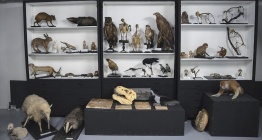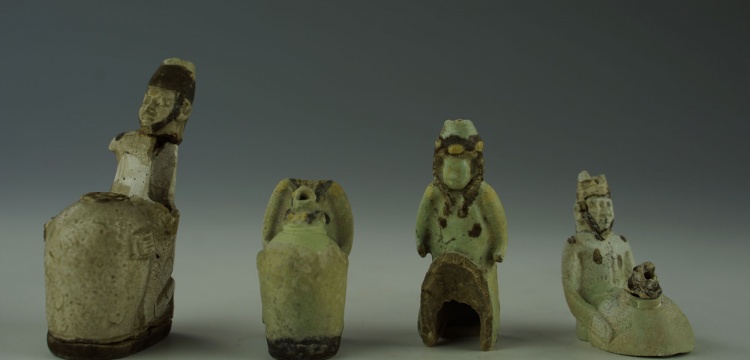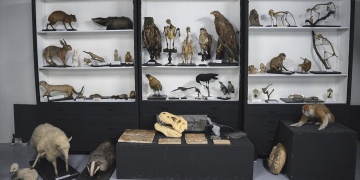It is the one who creates life against the destruction of drought. In the ancient Egyptian pantheon, Hapi is the god who represents the Nile river. Just like the Nile, he is the god of life, fertility and abundance.
Ritual Vessel
The details in the form of these scent containers depicting a person in the position of crouching on his toes, holding a storage container between his legs are as striking and mysterious as their function and the culture they belong to. This type of vessels has two spouts, one on the head of the figurine and the other on the figurine of a frog holded by the previous one at the front. These religious ceremonial vessels are thought to have been used for precious oils or perhaps the Nile water. It is believed that the palmy crown on the heads symbolizes Hapi, which characterizes the overflow of the Nile, and the frog on the storage container symbolizes the frog heralding fertility, namely the fertility goddess Heket, in the slime fallen astern by the overflow and subsequent withdrawal of the Nile.
The Nile River is undoubtedly one of the main characters of the formation of ancient Egyptian culture and the emergence of a world civilization from arid desert lands. It is the one who creates life against the destruction of drought. In the ancient Egyptian pantheon, Hapi is the god who represents the Nile river. Just like the Nile, he is the god of life, fertility and abundance. It is believed that he mediates in the fertility of the agricultural lands by making the Nile River overflow. The arrival of the Nile with floods is at the same time the arrival of Hapi. The fertility the Nile brings with its water is the fertility of Hapi.
Coming from the Temple of Athena in Smyrna / Bayraklı Mound and the Temple of Athena in Phokaia, these ritual vessels, where the symbols used together of Hathor, Bes, Hapi and Heket associated with abundance, rebirth and fertility were possibly produced in Naukratis, on the delta of Nile in Egypt and must have reached these lands in the middle of the 7th century and early 6th century BC as a result of the relations between Egypt and Ionia.








 İstanbul Müzelerinde 4 Mayıs Star Wars Gününe özel etkinlikler yapıldı
İstanbul Müzelerinde 4 Mayıs Star Wars Gününe özel etkinlikler yapıldı  Alinda Antik Kenti'nin 2500 yıllık yoluna asfalt döküldü. Kurul kararı ile temizlenecek
Alinda Antik Kenti'nin 2500 yıllık yoluna asfalt döküldü. Kurul kararı ile temizlenecek  Yüzen müze TCG Nusret Müze Gemisi 8 Haziran'a kadar Ege ve Akdeniz limanlarında
Yüzen müze TCG Nusret Müze Gemisi 8 Haziran'a kadar Ege ve Akdeniz limanlarında  İlm-i Hayvanat Müzesi'nde sergilenen türler İstanbul Üniversitesi Zooloji Koleksiyonu'nde
İlm-i Hayvanat Müzesi'nde sergilenen türler İstanbul Üniversitesi Zooloji Koleksiyonu'nde 




